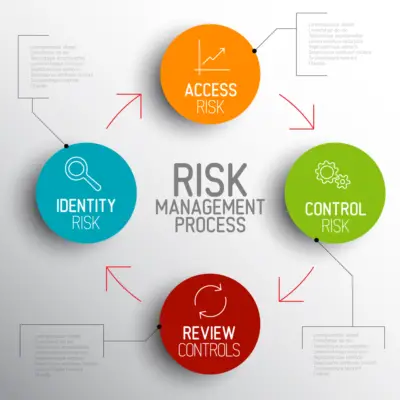In today’s dynamic business landscape, managing operational risks is crucial amid growing complexities.
As pivotal as this is, translating the theoretical knowledge into pragmatic applications necessitates a deep-rooted comprehension of Risk Control Self-Assessment (RCSA) and its various facets.
This article explains the Risk Control Self Assessment (RCSA) framework. It highlights its aim, methodologies, and role in risk management.
Much emphasis is placed on streamlining RCSA and its immense value proposition to businesses, providing clarity, fostering efficiency, and enhancing risk visibility.
Doing so requires embracing certain best practices and sharpened strategies to overcome associated challenges in the process of refining the RCSA process.
In our journey, we also glimpse the future, envisioning the progression path for RCSA and how innovations can elevate this from a standard compliance mandate to a strategic essential.
Understanding Risk Control Self-Assessment (RCSA)
Unleashing the Power of Risk Control Self-Assessment (RCSA)
In the fast-paced business world, emerging risks are as certain as the morning sunrise.
Navigating uncertain waters requires foresight, agility, and wisdom. Risk Control Self-Assessment (RCSA) is a vital risk management tool.
RCSA, at its core, is a proactive process utilized to identify and evaluate risks and controls within an organization.
It is not merely a one-off exercise but, rather, an ongoing process ingrained into the organization’s operational culture.
It empowers businesses to build resilience by shaping efficient and nuclear control mechanisms tailored to the unique risk profile of each business.
The brilliance of RCSA lies in its ability to draw on insights across all levels of an organization. Who better understands the intricacies of your business than your very own team members?
Through structured questionnaires, workshops, interviews, and control ratings, RCSA taps into this internal wellspring of knowledge to identify potential risks before they morph into costly disasters.
But how does it work? RCSA operates on a self-assessed basis where inherent and residual risks are evaluated.
As the name suggests, inherent risks are those that are integral to the business operation, while residual risks encompass those that evaded initial control measures.
Once risks are identified, controls are put in place. The efficacy of these controls is assessed against the identified risks.
If the controls are deemed adequate, they are then documented and monitored. If they are found wanting, RCSA triggers a process for addressing these gaps with more robust solutions.
However, RCSA is not a one-size-fits-all approach. Different businesses have diverse risk environments, hence the application of RCSA must be adaptable.
It acts as a customizable framework that adjusts to the unique needs and structural idiosyncrasies of an organization.
In a world of disruptive technologies and rapid market changes, taking a proactive stance on risk management is not an option but a competitive necessity. Early detection and mitigation through RCSA protect businesses from unexpected risks.
In today’s world, where agility is the king, RCSA acts as a compass, guiding organizations not just to survive but thrive amidst the choppy waters of uncertainty.
A well-implemented RCSA can be the loyal sentinel standing guard over your organization’s risk landscape.
The journey to business resilience is a pioneering endeavor that begins with the upfront recognition of risks.
Unleashing the power of RCSA is a key step towards steering your ship confidently into the dawn of a business future fortified against the uncertain yet promising tides of risk.

The Importance of Streamlining RCSA
Streamlining RCSA: The Linchpin in Effective Operational Risk Management
Streamlining RCSA (Risk Control Self-Assessment) is critical to reinforce the framework of strong operational risk management.
As the marketplace intensifies with competitive fervor and the business landscape becomes more volatile, the need for an efficiently optimized RCSA becomes more rigorous and non-negotiable.
So, why is it compulsory to streamline RCSA for successful operational risk management?
The answer lies in the consistent purpose that RCSA serves: to enhance risk visibility through self-evaluation.
A streamlined RCSA process eliminates potential blind spots, allowing for a comprehensive overview of inherent risks and, most importantly, the capacities of instituted controls to weather these risks.
Better visibility invariably translates to more robust risk management and, ultimately, business resilience.
The ultimate goal of risk management is not limited to just identifying potential risks., but evident in innovative companies’ dynamic approach to risk management – specifically, the balancing act of risk-taking in pursuit of business opportunities and administering sufficient control to tackle potential pitfalls.
In such scenarios, a streamlined RCSA acts as the intelligent partner, guiding decisions by delivering timely risk insights.
An optimized RCSA process aids in the creation of a ‘risk-aware’ culture. When RCSA is streamlined, it ensures a nuanced dissemination of risk awareness throughout the organization, thereby strengthening the foundation of operational risk management.
Such a risk-conscious culture can invariably assist an organization in navigating the intricate maze of compliance, laying the groundwork for a compliant, risk-matured, and hence, a more competent enterprise.
The benefits of an efficiently streamlined RCSA are also manifest in cost and time management.
Businesses can save resources by automating tasks, removing redundancies, and improving data reliability.
The apparent dual advantage is ensuring risk control and creating a strategic edge by freeing up resources for innovative pursuits.
As the world races towards digital transformation, the panorama of potential risks multiplies daily.
In such a reality, a streamlined RCSA, enhanced with advanced analytics and machine learning, can be an unaware system of ‘risk radar’ that scans, identifies, and alerts emerging risks.
It can essentially equip companies in these volatile times with a near-prescient ability to foresee risks and take preemptive action.
Last but not least, a well-structured RCSA drives accountability within organizations. When employees are more deeply involved in self-assessments, they naturally comprehend the gravity of their roles in keeping potential risks at bay.
This promotes a sense of ownership and responsibility, vital elements in making risk management a unified endeavor.
An effective operational risk management strategy is akin to steering a ship amidst uncharted and turbulent waters; having a streamlined RCSA in place is akin to having a reliable compass.
Not only serving as an early warning system for impending perils but empowering organizations to mold risks into opportunities towards the relentless pursuit of growth, robust performance, and unparalleled business resilience.
This is why streamlining RCSA is important and indispensable in operational risk management.

Best Practices for Streamlining RCSA
Streamlining Your RCSA: Toward a Robust Risk Management and Business Resilience
Crucial to achieving risk visibility and feeding into the long-term resilience of your business, Risk Control Self-Assessment (RCSA) optimizes awareness and management.
Your goal: to establish a streamlined RCSA process that brings robustness to risk management and delivers business resilience.
Streamlining the RCSA is pivotal in decision-making and in providing timely risk insights.
As an organization navigates fast-paced markets and unprecedented challenges, a well-curated RCSA becomes a critical instrument. Moreover, it provides a clear, comprehensive map of risk landscapes, helping leaders make informed, calculated decisions.
It offers robust, real-time insights into risk data, shaping strategic decisions and driving organizational growth.
One cannot overstate the importance of cultivating a ‘risk-aware’ culture, and RCSA is crucial.
It facilitates engagement, allowing every team member to partake in risk management discussions.
RCSA fosters proactive preparation, enabling organizations to anticipate, weather, and recover from the inevitable storms of business operations.
While assessing risks may seem time-consuming and costly, in reality, it is instrumental in preventing significant economic losses.
A streamlined RCSA cuts down on your risk management costs and time commitment, making it a worthy investment.
It reduces the possibility of unforeseen shocks, thus adding a cost-effective instrument to your risk management tool kit.
Technological advancements propel the RCSA’s capabilities to new heights. By harnessing advanced analytics and machine learning, you can streamline your RCSA process further.
These technologies transform raw data into insightful recommendations, aiding organizations in identifying intricate risk patterns and potential future threats.
Imparting a sense of accountability to the staff is integral to an effective RCSA. A well-structured RCSA promotes ownership of responsibilities and adherence to established risk management processes.
It provides transparency and encourages informed judgments, driving accountability across all levels of the organization.
Think of a streamlined RCSA through the analogy of a reliable compass. It’s an essential instrument to guide your vessel—your organization—through uncharted and turbulent waters.
The clarity and direction it offers are vital in successfully navigating operational risks and emerging unscathed.
In conclusion, elevating the practice of your RCSA to a streamlined state serves as fodder for better, insight-driven decision-making.
It cultivates a culture of risk awareness, saves both cost and time, offers a platform for advanced analytics, fosters accountability, and is a reliable guide in understanding and managing operational risk.
Thus, streamline your RCSA, and manage risks robustly for enhanced business resilience!

Overcoming Challenges in the Streamlined RCSA Process
Streamlining Risk Control Self-Assessment (RCSA) is fast becoming a priority for many organizations in the constantly changing business environment.
Organizations are increasingly identifying the need to improve the efficiency and effectiveness of their RCSA process.
However, some common challenges repeatedly crop up that need to be addressed to ensure a streamlined approach towards RCSA. Let’s delve into these pitfalls and how to effectively navigate them.
The first challenge lies in creating an effective and efficient system to gather, analyze, communicate, and manage risk data.
Inconsistent risk data collection methods and tools can lead to inaccuracies in risk assessments.
Organizations can transform this challenge into an opportunity by investing in a robust data collection platform and leaning into cutting-edge technology like artificial intelligence and machine learning.
This tech-driven approach can ensure a more analytical risk evaluation process, leading to more accurate outcomes and actionable insights for decision-making.
Next up is the challenge of accountability. Oftentimes, there’s a disconnect between the responsibility and accountability for managing risks in an organization.
This issue can be addressed by establishing strong ownership using a clear risk ownership structure and a top-down management approach.
When everyone from the CEO to the frontline staff understands and accepts their risk-related responsibilities, organizations reap the rewards of a culture of risk awareness, which is crucial for mitigating risks and promoting resilience.
Complexity is the next hurdle to streamlining the RCSA process. Given the multiplicity of risks and diversity of business operations, simplifying the RCSA process is no small feat.
However, adopting standard metrics, common language, and uniform control standards can significantly reduce RCSA complexity.
Incorporating these standards across all departments can help roll out a systemic and streamlined approach to the RCSA process, resulting in improved efficiency and reduced ambiguity.
Moreover, cost-effectiveness can often be a roadblock for organizations trying to streamline their RCSA process.
Efficient RCSA processes eliminate redundancies and unnecessary checks, reducing costs and time used in carrying out risk assessments.
Proactively investing in streamlining the RCSA process, therefore, can provide cost and efficiency benefits in the longer term.
Finally, organizations grapple with the difficulty of maintaining an updated RCSA process that reflects changes in the risk landscape, industry regulations, and organizational goals and strategies.
The solution lies in nurturing a dynamic RCSA framework, one that evolves with the changing requirements. An adaptable RCSA that is regularly reviewed can ensure it remains relevant and useful.
These challenges can be overcome by utilizing technology, adopting a top-down approach to risk management, standardizing risk measurements, promoting cost-effectiveness, and ensuring that RCSA remains dynamic.
As the compass guiding organizations in the uncertain waters of risk management, a streamlined RCSA can only strengthen resilience, decision-making capabilities, and business resilience.
Organizations equipped with these obstacle-overcoming strategies can fully harness the potential of an effective, streamlined RCSA process.

The Future of RCSA: Innovations & Improvements
The landscape of Risk Control Self-Assessment (RCSA) is undoubtedly on the precipice of considerable change.
The future patterns predict a heightened emphasis on transformative technologies and a solution-driven approach to augment the efficiency and precision of the RCSA.
Artificial Intelligence (AI) and Machine Learning (ML) are already disrupting the status quo of risk management.
Their incorporation into RCSA processes will further enhance the identification, evaluation, monitoring, and control of risks.
Predictive analytics derived from these technologies will fortify risk insights, facilitating proactive management strategies to curb any foreseeable threats.
The adoption of Blockchain in RCSA could become a palpable reality. Blockchain’s traceability and immutability characteristics make for greater transparency, ensuring efficient tracking and control of risks.
Distributed Ledger Technology (DLT) can facilitate seamless information sharing across the organization, promoting a united front in risk management.
Cloud computing is another harbinger of change. By migrating RCSA processes into a cloud environment, organizations can reap many benefits, including cost-efficiency, scalability, and increased data security.
This digital leap will entail a significant enhancement in RCSA’s ability to adapt and respond to evolving risk profiles quickly.
In the future, RCSA will play a critical role in orchestrating sustainable practices. It will act as the lynchpin to develop and drive ethical business operations, emphasizing the importance of corporate social responsibility in the risk management discourse.
The landscape of RCSA will also see the advent of a more integrated and inclusive approach.
The siloed, restrictive model will give way to a cross-functional alignment. This collaborative approach will break the barrier of departmental confines, encouraging a comprehensive understanding of risk exposure and reinforcing an all-encompassing, risk-aware culture.
Another transformative trend that will mold the future landscape of RCSA is agility. As the pace of change accelerates, so does the need for risk management processes to keep up.
Agile RCSA will not merely respond to change but also harness it, aligning risk controls with shifting strategic, market, and regulatory landscapes.
The future also heralds the closer integration of RCSA with corporate strategy. By aligning RCSA with strategic goals, organizations can galvanize a culture that considers risk in every business decision, magnifying resilience capabilities.
This strategic alignment will cascade down, permeating throughout operational, tactical, and functional echelons.
Driven by technological advancements, increasing regulatory imperatives, and an acute awareness of the impact of risks, the future of RCSA will be one of relentless evolution, driving it from a procedural obligation to a strategic enabler.

Conclusion
Through the lens of this in-depth exploration, one can conclude that Risk Control Self-Assessment (RCSA) is not just a standard regulatory requirement but a strategic tool and a business essential.
Embracing streamlined approaches and best practices can revolutionize its impact on operational risk management.
Despite the challenges faced in the process of refining this crucial tool, the effective strategies highlighted, such as fostering a risk culture and integrating technological tools, can provide a roadmap towards overcoming these.
Looking optimistically towards the future, RCSA promises a vista teeming with innovative agility, reshaping businesses profoundly.
Thus, experts and professionals alike must continue their pursuit of knowledge and adapt to the changing dynamics of RCSA, positioning it as a strategic necessity rather than a regulatory obligation.

Chris Ekai is a Risk Management expert with over 10 years of experience in the field. He has a Master’s(MSc) degree in Risk Management from University of Portsmouth and is a CPA and Finance professional. He currently works as a Content Manager at Risk Publishing, writing about Enterprise Risk Management, Business Continuity Management and Project Management.


